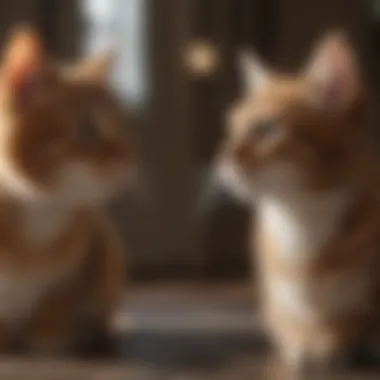A Comprehensive Guide to Introducing a Kitten to an Older Cat


Intro
Introducing a new kitten into a home with an older cat can evoke mixed feelings. The excitement of welcoming a playful addition contrasts with the concern for the existing feline’s comfort. Understanding feline behavior and creating a suitable environment for both animals is critical.
This guide offers practical insights on how to facilitate a positive relationship between a kitten and an older cat. Adopting a systematic approach that prioritizes gradual introductions and careful monitoring of interactions can lead to a harmonious coexistence.
Key topics covered include considerations for pet care essentials, behavioral training, creating a suitable home environment, and health-related topics. The goal is to equip pet owners with comprehensive strategies that promote the well-being of both pets and household dynamics.
Pet Care Essentials
Daily Nutrition Requirements
Nutrition plays a pivotal role in the health of both kittens and older cats. Young kittens require more calories and nutrients to support their rapid growth. Owners should consider providing high-quality kitten food rich in protein. Older cats, while they may not require as many calories, need nutrient-dense meals to maintain their health.
It is advisable to consult with a veterinarian regarding the specific dietary needs of each cat to tailor their nutrition effectively.
Exercise and Playtime
Both kittens and older cats benefit from regular exercise and mental stimulation. Kittens naturally have higher energy levels, while older cats might prefer shorter bouts of play. To accommodate both, it’s essential to create a routine that includes interactive play as well as independent play opportunities, fostering engagement while respecting the older cat's energy levels.
Grooming Tips
Grooming is vital in maintaining a cat's health. It can be a bonding experience for both cats. Kittens may not yet have the grooming habits of an adult cat, so establishing a routine can help them adapt. Older cats may require more frequent brushing, especially if they have long fur, to avoid matting and skin issues.
Health and Wellness Check-ins
Routine check-ups with a veterinarian are essential for both kittens and older cats. Early detection of health issues can greatly impact treatment efficacy. Keeping up with vaccinations, parasite prevention, and dental care ensures both cats remain healthy and happy.
Behavior & Training
Understanding feline behavior is pivotal in easing the introduction process.
Understanding Your Pet's Body Language
Cat body language signals are subtle and often misunderstood. Paying attention to how each cat communicates can provide insight into their feelings. For instance, an arched back can indicate fear, while purring might suggest comfort. Knowing these signals can help pet owners manage interactions effectively.
Basic Training Techniques
Training should be approached positively to be effective. For kittens, introducing basic commands and litter training early on is beneficial. Using treats and praise reinforces desirable behaviors, contributing to a smooth transition.
Behavioral Concerns & Solutions
Some behavioral issues may arise during the introduction phase. It’s essential to monitor for signs of aggression or stress. Separating the cats when needed and allowing for gradual exposure can alleviate tensions. Positive reinforcement for calm behavior during interactions is key.
Socialization Tips
Socialization is critical for kittens. Early exposure to various situations can help them grow into well-adjusted cats. Create opportunities for socialization with the older cat while respecting their comfort levels, gradually increasing the time they spend together.
Pet Home Environment
Creating a safe space for both cats is essential for a successful introduction.
Creating a Pet-friendly Space
Designating separate areas for each cat helps reduce territorial behavior. Each cat should have access to their food, water, litter box, and resting area. This prevents any feelings of competition and provides safe zones as they get used to each other.
Safety Measures and Hazards to Avoid
Identify and remove potential hazards from the home environment. This includes securely storing cleaning supplies, toxic plants, and small objects that could pose choking hazards. A safe environment minimizes risks, ensuring both cats can explore without harm.
Choosing the Right Toys and Accessories
Selecting appropriate toys can foster positive interactions. Different types of toys cater to the play styles of both creatures. Providing scratching posts, interactive toys, and hiding spots promotes healthy play and reduces stress.
Setting Up a Comfortable Resting Area
A comfortable resting area is essential for both cats, especially the older one. Cats need quiet places to retreat. Providing soft bedding and perches gives them options to relax while observing each other from a distance.
Pet Health Issues
Monitoring health issues is crucial during this transition.
Recognizing Signs of Illness
Recognizing early signs of illness can save lives. Changes in appetite, litter box habits, or behavior might indicate a health concern. Owners should remain vigilant during the introduction phase.


Preventative Care Measures
Preventative care includes vaccinations, flea control, and regular vet visits. Discussing these topics with a veterinarian will help maintain both cats' health.
Common Ailments and Treatments
While kittens might be prone to different issues than older cats, knowing common ailments helps owners provide appropriate care. Ensuring both pets are up to date with their health checks can prevent problems from escalating.
Emergency Preparedness
Planning for emergencies is vital. Keep a basic first aid kit handy and know the location of the nearest veterinary clinic. Being prepared can greatly ease panic during unforeseen situations.
Caring for both an older cat and a kitten requires thoughtfulness and preparation. Paying attention to their needs fosters a loving and peaceful home.
Understanding Feline Behavior
Understanding feline behavior is crucial when introducing a kitten to an older cat. This knowledge allows pet owners to anticipate reactions, manage interactions, and ensure the comfort of both animals. Recognizing the underlying instincts and social tendencies of cats can help in carving out a peaceful integration strategy.
The Nature of Cats
Cats are inherently territorial. They thrive in environments where they feel secure and in control. When a new kitten enters the space, the older cat may perceive this as an intrusion. This can trigger a variety of responses, ranging from curiosity to aggression. Understanding this natural instinct assists owners in planning introductions more effectively.
Cats also display unique personalities, influenced by factors such as age, breed, and past experiences. Therefore, it is essential for cat owners to consider these individual traits when forming an introduction plan.
Social Structures in Cats
Cats are social animals, yet they operate within a hierarchical structure. This structure often determines how they interact with one another. Adult cats tend to prioritize their autonomy and may resist sharing space or resources. This preference for solitude can lead to conflict when a lively kitten arrives.
Observing the social dynamics during the introduction is important. In some cases, the older cat may take on a mentoring role, while in others, they may feel challenged to assert dominance. Understanding these dynamics allows owners to foster a positive environment where both cats can coexist.
Behavioral Signs of Stress
Recognizing behavioral signs of stress is vital in this process. Cats communicate their discomfort through various signals, such as:
- Hiding or avoiding the new kitten
- Increased vocalization, often in the form of hissing or growling
- Changes in eating or litter box habits
- Over-grooming or other compulsive behaviors
These behaviors indicate that the older cat is struggling with the change. Owners should monitor these signs and take proactive steps to alleviate stress. Offering a separate, quiet space for the older cat can promote their sense of security.
Familiarizing oneself with feline behavior enhances the chance of a successful integration. It also supports the overall emotional well-being of both the older cat and the new kitten.
Preparation Before the Foreword
Before embarking on the journey of introducing a kitten to an older cat, it is vital to prepare adequately. This preparation phase significantly influences the success of the introductions and helps mitigate potential stress for both animals. Each step taken during this preparation contributes to a smoother transition and promotes a sense of safety and comfort within the household.
Assessing Your Older Cat's Temperament
Understanding your older cat's temperament is essential. Cats have distinct personalities, and their reactions to a new kitten may vary widely. Some older cats might exhibit curiosity, while others may display territorial behavior or anxiety. To assess their temperament:
- Observe how your older cat interacts with new experiences, sounds, and other animals.
- Take note of their usual behaviors during changes in the home, such as renovations or the arrival of guests.
- Consider consulting a veterinarian for insights on any behavioral issues that could surface during the introduction.
Recognizing these traits can help in tailoring the introduction approach to minimize stressors.
Creating a Safe Space for the Kitten
A designated safe space for the kitten is crucial during the initial transition phase. This area should be secluded from the older cat, offering a comfortable and calm environment. Benefits of a safe space include:
- Providing the kitten a retreat to adjust to its new surroundings.
- Allowing the older cat to maintain its territory, reducing feelings of threat or anxiety.
This safe space can include essentials like a litter box, food and water bowls, a cozy sleeping area, and some stimulating toys. Make sure the space has minimal traffic from the older cat, giving the kitten freedom to explore when comfortable.
Gathering Essential Supplies
Lastly, preparing the right supplies plays an important role in both comfort and functionality. Gathering essential supplies ensures that both the older cat and the kitten are well-catered during this transitional period. Common items to consider include:
- Separate food and water stations for each cat to avoid resource guarding.
- Litter boxes placed in different locations, ideally one for each cat, plus one extra to prevent territorial disputes.
- Scratching posts and interactive toys to keep them engaged and reduce boredom.
- Safe hiding options for the kitten in case it feels overwhelmed.
By having these supplies ready, the home becomes equipped to meet the needs of both cats effectively, creating a more peaceful environment and supporting the transition.
Remember, patience and observation are key components throughout this process. Pay attention to the needs and behaviors of both your older cat and newly introduced kitten for a successful introduction.
The Gradual Prologue Process
Introducing a kitten to an older cat must be done with careful thought and planning. The gradual introduction process is crucial as it helps mitigate potential conflicts and stress for both pets. Cats are territorial by nature, and sudden changes in their environment can lead to anxiety. Taking steps to introduce them slowly can result in a peaceful coexistence, which benefits both the kitten and the older cat. Understanding the dynamics presented in this phase helps reinforce safe boundaries while fostering trust among the animals.
Initial Separation Strategy
The first step is to keep the kitten and the older cat separated. This separation allows both animals to acclimate slowly to the presence of the other. It is critical to provide each pet their own space for relaxation and retreat.


- Use Separate Rooms: Begin by designating a safe, quiet room for the kitten. Ensure it is equipped with essentials like food, water, a litter box, and a cozy bed.
- Short Interactions: Initially, allow each cat to explore their spaces freely while knowing that the other exists nearby. This can relieve some anxiety, as both pets will start to acclimate to the sound and scent of one another without direct contact.
"Taking the time to create a safe and comfortable environment for both cats is key to a successful introduction."
Scent Swapping Techniques
Scent is an essential component of feline interaction. To facilitate this introduction phase, make use of scent swapping. This method allows both cats to familiarize themselves with each other’s smell, reducing the shock of direct contact later.
- Using Towels: Gently rub a cloth or towel on the older cat, then on the kitten. This should be done multiple times, allowing the smells to mix.
- Playful Toys: Introducing toys can also be effective. Allow the older cat to play with a toy, then give that toy to the kitten to explore. This method promotes positive associations with another cat’s scent.
Controlled Viewings
Once some understanding of each other's scents has been established, the next step involves controlled viewings. This is an opportunity for the cats to observe each other in a safe environment.
- Use a Barrier: A baby gate or a cracked door can effectively separate them during the initial introduction phase. This limits direct confrontation while allowing for visual contact.
- Monitor Behavior: Pay close attention to their body language during these sessions. If either cat shows signs of severe stress, be ready to separate them and take a step back.
These methods facilitate a gradual acclimatization process, ensuring both the kitten and the older cat feel secure with each other's presence. By taking these small but purposeful steps, cat owners increase the likelihood of a harmonious relationship between their pets.
Monitoring Interactions
Monitoring interactions between your kitten and older cat is crucial during the adjustment period. This phase can determine the long-term success of their relationship. Both animals might exhibit various signals that indicate their comfort or discomfort levels. Understanding these interactions enables you to proactively manage behaviors, ensuring both cats feel secure and less threatened.
Paying attention to how they relate to each other can help you identify potential issues early. This responsibility extends beyond simple observation; it is about interpreting their behaviors correctly and intervening when necessary. This can lead to a more harmonious living environment, as a misstep in interpretation may lead to conflicts that could have been avoided.
Body Language Indicators
Body language plays a significant role in communicating emotions between cats. Cats are masters of non-verbal cues. Observing these can reveal their feelings about one another. Here are some key body language indicators to watch:
- Tail Position: A cat holding its tail erect is often feeling confident and happy. Conversely, a low or puffed-up tail suggests fear or aggression.
- Ears Orientation: Forward-facing ears indicate curiosity. If the ears are pinned back, the cat may feel threatened or annoyed.
- Eyes: Slow blinking can indicate trust. If the cat is staring intensely, it might be signaling a challenge or threat.
- Posture: Relaxed posture and gentle movements show comfort, while a tense body or crouching can indicate stress.
Being aware of these signs helps in assessing the dynamics as they develop. A young kitten may be more playful and energetic, while an older cat might prefer calmness. Understanding each cat's baseline behavior can help you discern any changes that may suggest stress.
Identifying Positive Engagement
It is as important to recognize the signs of positive engagement as it is to note stress indicators. Positive interactions can lead to a strong bond between the two cats. Look for the following behaviors:
- Mutual Grooming: When both cats groom each other, it is a strong sign of affection.
- Play Invitations: If either cat shows interest in play, such as chasing or pouncing, this indicates a willingness to engage.
- Shared Spaces: Seeing both cats comfortably cohabitating in the same room or resting near each other is a positive indicator.
- Vocalizations: Gentle purring, chirping, or quiet meows can indicate they are content in each other’s presence.
These aspects of engagement show that both cats are becoming accustomed to each other. This is a crucial time that requires keen observation to ensure both animals' emotional well-being.
When to Intervene
Intervention is essential in cases where interactions become aggressive or overly stressful. Taking a step back can help you assess whether intervention is necessary. Here are instances that warrant your immediate attention:
- Hissing or Growling: These sounds indicate discomfort or agitation and should be addressed quickly.
- Biting or Swatting: If either cat resorts to physical aggression, it is vital to separate them immediately to diffuse the situation.
- Prolonged Staring: If you notice one cat fixating intensely on the other, it can lead to confrontation.
- Signs of Stress: If either cat displays excessive hiding or avoidance behaviors, it may need space from the other.
Intervening doesn't necessarily mean forcing them apart. It might simply involve redirecting their focus or providing a distraction. In severe cases, it may be necessary to return to a previous step in the introduction process.
Monitoring interactions will help you gauge the progress of introductions. This attention is essential for fostering a peaceful coexistence.
Encouraging Positive Relationships
Encouraging positive relationships between a new kitten and an older cat is critical for creating a harmonious home environment. This aspect of introduction focuses on fostering mutual respect and companionship. Not only is a positive relationship beneficial for the cats, but it also enhances the well-being of the entire household.
When both pets feel safe and comfortable, there is less likelihood of stress-related behaviors, which can include aggression or avoidance. A strong bond allows cats to coexist peacefully, potentially leading to playful interactions rather than confrontations. The following sections delve into specific strategies that can help build these positive relationships.
Joint Play Sessions
Joint play sessions are an effective method to encourage interaction between a kitten and an older cat. These sessions promote physical activity and mental stimulation, essential for both animals. Introducing shared toys, such as feather wands or laser pointers, can engage them simultaneously and create a sense of teamwork.
- Set the Scene: Begin in a neutral space to avoid territorial behaviors. Ensure there are multiple toys available to prevent one pet from monopolizing playtime.
- Supervise Interactions: Always monitor their play to prevent any roughhousing that could lead to injuries or stress. Gradually increase the duration of play sessions as comfort levels rise.
Creating positive associations with joint play can lead to comfort around each other. Over time, they may naturally seek each other’s company during these sessions.
Feeding Strategies for Cohesion
Feeding time presents another opportunity to foster positive relationships. Implementing feeding strategies that encourage togetherness can greatly enhance their bond.
- Simultaneous Feedings: Offer their meals at the same time but in separate, designated areas. This promotes the idea of shared routines without direct competition for resources.
- Positive Reinforcement: Rewarding both pets for calm behavior while eating can reinforce positive experiences. Treats can also be shared when they are relaxed together.
Utilizing mealtime as a bonding experience reinforces a sense of cooperation and reduces food aggression. Consequently, it establishes a foundation for a trusting relationship.
Create Shared Spaces
Designating shared spaces in your home can help facilitate comfort and connection between your kitten and older cat. These areas should be safe, cozy, and accessible to both pets.


- Safe Zones: Establish spots like a sunny window perch or a large comfy bed where both cats can relax together. Make sure that escape routes are always available, as this gives them a sense of security.
- Personal Items: Use items that smell like each animal to encourage familiarity. Allow both cats to explore these spaces on their own terms to lessen anxiety.
Creating shared spaces fosters a sense of community. Over time, both cats may start to feel relaxed in each other’s presence, enjoying their time together in a stress-free environment.
Building a positive relationship requires patience and effort. Focusing on shared activities, such as play and feeding, can yield rewarding companionship.
Encouraging these positive interactions can lay the groundwork for a lasting friendship between your older cat and the newcomer. It is essential to remember that each cat adjusts at their own pace. Adjusting strategies according to individual needs will ensure the best possible outcome.
Addressing Potential Conflicts
When introducing a kitten to an older cat, addressing potential conflicts is crucial. Both animals have established routines and behaviors. Sudden changes can disrupt their equilibrium, causing stress and aggression. Recognizing and managing these conflicts can prevent negative interactions and enhance the likelihood of a harmonious relationship.
Understanding common behavioral issues is the first step. It's helpful to know how each cat usually behaves. The older cat might feel threatened, while a kitten's playful antics can be perceived as harassment.
Common Behavioral Issues
Felines communicate primarily through body language and vocalizations. Here are some common issues that might arise during the introduction:
- Aggression: An older cat might display aggression if it feels its territory is being invaded. This may lead to hissing, swatting, or growling.
- Fear: The new kitten can bring anxiety, causing the older cat to hide, avoid interactions, or even refuse to eat.
- Overstimulation: Kittens often have boundless energy, which can overwhelm the older cat, leading to irritability or withdrawal.
Recognizing the signs early is crucial. Observing their interactions can provide insights into their comfort levels.
Effective Conflict Resolution Tactics
If conflicts occur, implementing effective resolution strategies is essential. Here are several tactics that can help mitigate tensions:
- Redirect Attention: Use toys or engage in play with the kitten to distract from the older cat. This diverts excess energy and reduces tension.
- Safe Spaces: Ensure the older cat has retreat options. Providing high perches or secluded areas can help them feel secure.
- Positive Reinforcement: Rewarding calm behaviors in both pets reinforces good interactions. Treats or praise can encourage them to associate each other’s presence with positive outcomes.
These strategies help foster coexistence and minimize conflicts.
When to Seek Professional Help
Sometimes, despite best efforts, issues can persist. Knowing when to consult with a professional is essential. Here are signs that might indicate the need for expert intervention:
- Severe Aggression: If one of the cats is consistently aggressive, despite your attempts to mediate, this is a serious concern.
- Trauma or Injury: If either cat suffers from injuries or extreme anxiety as a result of encounters, it may indicate deeper psychological issues.
- Behavioral Changes: Noticeable shifts in the older cat's behavior, like refusal to eat or changes in litter box habits, warrant immediate attention from a veterinarian or animal behaviorist.
Adjusting to the New Normal
Introducing a kitten into a home with an older cat inevitably changes the dynamics of the household. Understanding how to adjust to these changes can help ensure a harmonious living environment for both animals. The emotional and physical well-being of all pets involved rest on the owners' ability to navigate this new normal. Adapting routines and interaction patterns not only promotes peace but also fosters a safer and happier home for all.
Monitoring Long-term Dynamics
After the initial introduction phase, it is critical to monitor interactions over time. Observing both cats' behavior can reveal insights into their evolving relationship. Look for signs of comfort and stress. Regularly checking how they interact will enable owners to identify improvements or issues promptly. This can involve watching for body language cues such as tail position or ear orientation. Cats communicate more than we often realize, and paying attention to these signals can guide future interactions and adjustments to care.
Creating Individual Routines
Every cat has its own needs, which may require the establishment of separate routines. Each pet should have designated time for feeding, play, and relaxation. This helps reduce potential competition and stress. Owners might implement feeding schedules that allow each cat to eat in peace, away from the other. Play sessions should also accommodate both cats, ensuring that the older cat still receives attention and engagement alongside the newcomer. Develop individual routines to serve their unique personalities, while allowing for some joint activities as they grow more comfortable.
Maintaining a Calm Environment
A tranquil home setting is essential in easing the transition for both the older cat and the kitten. Minimize disruptions during the adjustment period. Maintaining consistent sounds, smells, and routines can greatly assist in this regard. Soft music or white noise may create a soothing atmosphere. Providing safe spaces where each cat can retreat ensures they feel secure when overwhelmed. Owners should also aim to reduce external factors that might cause stress, such as loud noises or significant changes in household activity during the initial adjustment phase.
"Creating a calm environment is not merely about physical space. It involves recognizing and addressing the emotional needs of both pets."
Overall, adapting to a new normal involves ongoing observation, thoughtful adjustments to routines, and a commitment to creating a serene atmosphere. Cats thrive under stability and routine, promoting their mental health and the peace of the household.
Evaluating Success of the Prelims
Evaluating the success of introducing a kitten to an older cat is crucial for understanding the dynamics of their relationship. This phase helps owners to recognize whether the two animals are transitioning well together. Not only does it provide insights into their behavior, but it also highlights any issues that may arise during the adaptation period. Monitoring interactions allows you to assess the emotional well-being of both pets and ensures a peaceful coexistence in your home.
Signs of a Harmonious Relationship
Identifying the signs of a harmonious relationship between your older cat and the new kitten is essential. Look for positive behaviors that indicate comfort and acceptance. These may include:
- Playful interactions: If both cats engage in playful behavior, it shows that they are starting to bond. This can range from gentle tussles to shared toys.
- Mutual grooming: Cats often groom each other as a sign of affection and trust. If you see this behavior, it reflects a good relationship.
- Relaxed body language: Signs such as tail position or ear alignment can indicate feelings. Observing the kittens and cats lying together or approaching each other comfortably is a positive signal.
The presence of these indicators means that the introduction is proceeding well and both animals are beginning to establish a relationship.
Gradual Adjustments to Daily Life
Adapting daily routines to accommodate both pets is an important aspect of their integration. It may involve:
- Maintaining separate feeding areas: Initially, it may be necessary to keep their food and water bowls separate until they are more comfortable with each other. This helps to prevent competition or food aggression, which can arise in multi-pet households.
- Adjusting playtime: Scheduling playtime when both pets can be included helps to foster a sense of community. This gradual inclusion encourages positive interactions while keeping stress levels low.
- Shared but controlled environments: Allow them to explore shared spaces but supervise their activities closely. This stage helps to develop their relationship in a safe setting.
These gradual adjustments help both your older cat and the kitten to feel secure, ultimately enhancing their feelings of acceptance and comfort within the shared home.
Continued Observance and Adaptation
Even after initial signs of harmony are displayed, continued observance is essential. Regularly reassess interactions to ensure that both pets are thriving. Consider focusing on:
- Ongoing monitoring for signs of stress: Be attentive to any changes in behavior, such as hiding, aggression, or excessive vocalization. These can indicate discomfort and may require intervention.
- Adaptation of routines based on behavior: If one pet is showing signs of stress, adjust their routine or environment accordingly. This might include providing additional playtime or separate spaces for retreat.
- Emotional support for both pets: Understand that the older cat may take longer to adapt. Offer reassurance through positive reinforcement, such as treats or praise, when they engage positively with the kitten.
As the relationship develops, ongoing observation becomes vital for maintaining a tranquil environment. These considerations will lead to a stable and healthy companionship if managed carefully.







